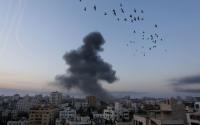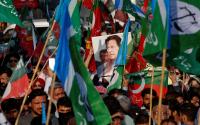The Atlantic.onlineJuly/August 2003
The Wall
Whenever hopes for peace between Israelis and Palestinians rise, a new surge of bloodshed extinguishes them. Palestinian suicide bombings provoke Israeli military attacks, which provoke more suicide bombings, which provoke more military attacks. Now the Israelis are trying to stop the violence by building a 225-mile wall—variously consisting of concrete, barbed wire, electronic fencing, motion detectors, and trenches—that will separate the Jewish state from the West Bank. It will be completed this year and will profoundly change the geographical and political landscape of the Israeli-Palestinian conflict.
The wall is the most ambitious attempt by Israelis to reclaim the relative quiet they enjoyed before the second intifada, which began in September of 2000 and has since subjected Israel to a relentless wave of suicide terrorism. The logic behind the wall is unassailable. Israel's other borders (with Lebanon, Syria, Jordan, Egypt, and Gaza) are fairly well protected; none has the security problems with terrorist infiltrators that exist on the frontier with the West Bank. The Gaza Strip, for example, was a major departure point for Palestinian terrorist strikes into Israel before it was fenced off, in 1994. Since the current intifada began, no Palestinian suicide bomber has entered Israel from Gaza.
Polls show that at least 70 percent of Israelis support physical separation from the West Bank. However, many of the 200,000 Jewish settlers who live there oppose the wall, for a simple reason: once it is finished, the Israeli army will no longer provide the level of protection settlers currently enjoy. Few settlers are likely to want to remain outside the wall, given their increased vulnerability to attack; most will probably move back to Israel. Thus the wall could spell the death of the attempt to settle Greater Israel, which encompasses the biblical lands of Judea and Samaria and includes the West Bank. It will also create a de facto international border.
The idea of the wall also makes many Palestinians unhappy, because it will not exactly follow the Green Line—Israel's pre-1967 border with the West Bank. Instead it will reach into the West Bank to embrace some nearby Jewish settlements. Palestinians consider this a land grab. In addition, the wall will further weaken the already severely damaged Palestinian economy in the short run, since entry into Israel will be more difficult. As Palestinians are forced to turn elsewhere for jobs and income, however, the impetus for a more self-reliant and robust Palestinian economy could emerge.
But the wall could also deepen Palestinian rage and enmity, of course, prompting escalated mortar and ground-to-ground missile attacks against targets inside Israel. Hamas has already launched such attacks from the Gaza Strip, and it may now do so from the West Bank. The wall could also prompt further attacks on Israelis overseas, like the suicide bombing last November of a Mombasa hotel filled with Israeli tourists and the accompanying attempt to shoot down an Israeli chartered plane.
Bruce Hoffman
* * *
A Shrinking Russia
The population of Russia is getting smaller and older. In 1992 the country's population was estimated at 148 million; today the number is 145 million. That's an absolute decline greater than that in any other nation during the past decade—and some analysts predict that the number of people in Russia will drop below 100 million by 2050. The number of Russians aged fifteen to twenty-four, though temporarily growing because of high birth rates in the 1980s, may shrink by nearly half over the next fifteen years, because of low birth rates in the 1990s. This will greatly strain a country that is already struggling to cope with a daunting array of security challenges, including controlling the world's longest borders and largest land mass, maintaining the world's largest nuclear arsenal, and reining in one of the world's most serious weapons-proliferation problems.
From the archives:
"Dead Souls" (January 1999)A prominent demographer warns that the spread of tuberculosis and AIDS in Russia will soon make Western hand-wringing over the pace of Russian "economic reform" seem quaint. By Murray Feshbach The security implications of this demographic change become clear when one examines its effect on Russia's military, police, border guards, and other security forces, which in coming years won't be able to fill their ranks. And more is at issue than a simple decline in numbers. Young Russian men, the population from which the military and other security agencies draw most of their personnel, are today plagued with health problems, among them alcoholism (a long-standing problem), tuberculosis (a returning scourge), and HIV/AIDS (a rapidly emerging new epidemic). The mortality rate among Russian men aged fifteen to twenty-four nearly doubled in the 1990s and is now almost three times that among American men of the same age. The rate of death from suicide, one of the leading killers of young Russian men today, is more than three times that for young American men. And many young Russians who are fit for (ostensibly compulsory) military service bribe their way out of it, leaving a force even less healthy than the military-age population as a whole.
Unlike many European states that also have shrinking populations of young people, Russia isn't currently in a position to compensate for a loss of manpower by putting more money or technology into its military and other security organs, because the country's economy and scientific sectors have suffered considerably during the past decade. And as the country's population ages, burgeoning pension obligations will drain away resources that could otherwise have been devoted to security. Although immigration might mitigate some of the population loss and help to fill the ranks, the trend is not encouraging: immigration has plummeted from more than 1.2 million in 1994 to fewer than 185,000 in 2002. Russia could try to expand its military ranks, at least, by relying more on women soldiers, but the military's attitude toward women is hostile in many ways, and cultural adjustments simply will not come quickly.
Without enough manpower to police its extensive borders and to respond effectively to internal and external security problems, Russia could well lose its battles against smuggling, terrorism, and weapons proliferation—all threats that pose dangers far beyond Russia's borders.J
Julie Davanzo, Olga Oliker, & Clifford Grammich
* * *
The Hindu-Muslim Divide
A defining element of Indian politics since independence has been a commitment to secularism. That commitment is now at risk from an aggressive brand of Hindu nationalism that equates Indian national identity with Hindu religious identity. The country's radical nationalists view the secular political system as a threat to Hindu identity, largely because of the power it offers India's 140 million Muslims. Weakening, or even abolishing, the secular state has therefore become part of the radical-nationalist agenda. This may force Indian Muslims—traditionally moderate and supportive of the secular state, even on the sensitive matter of Kashmir—to shift their allegiance from the state to some sort of larger international Islamic movement, as many Muslims have done in Indonesia, Malaysia, and Singapore. Such a radicalization of religious identities is a matter of serious concern in a nation of a billion people that possesses the world's seventh largest nuclear arsenal and has had troubled relations with its populous and nuclear-armed Muslim neighbor, Pakistan.
Radical Hindu nationalism is already a dominant force in mainstream Indian politics. A Hindu nationalist party, the BJP, has led the country's coalition government for five years, and extremist Hindu organizations with explicitly anti-Muslim sentiments have heavily influenced the party's agenda. Strife between Hindus and Muslims has been the predictable result. Last year a group of Muslims burned a train full of nationalist Hindus in the state of Gujarat; the attack killed fifty-eight people and led to Hindu reprisals that killed about 2,000 Muslims. An Indian tribunal investigating the massacres found that Hindu nationalist groups had methodically targeted Muslim homes and shops. It even charged that one important group, the VHP, had recruited and trained militants for the violence, and had provided them with computer printouts of names and addresses. Local and national security forces failed to respond adequately to the crisis as it unfolded: initially the state police did not intervene, and the central government only belatedly sent troops to Gujarat to restore order. Although thousands of extremist Hindus were involved in the violence, few were arrested. On the whole, the Gujarat episode has left Indian Muslims feeling neglected by the government.
The radicalization of India's Hindus and Muslims poses obvious domestic-security challenges. According to recent reports, Muslim militants based in Kashmir have been working with Pakistani groups to target the VHP and other groups in retaliation for the massacre in Gujarat. Militant Hindu groups have vowed to destroy Muslim mosques throughout India, and to build temples in their place.
Rollie Lal
* * *
AIDS and African Armies
The devastating impact of the AIDS pandemic in Africa is well known. According to the United Nations, some 28 million people in sub-Saharan Africa now live with HIV/AIDS, and in some countries the rate of HIV infection approaches 40 percent of the adult population. AIDS claimed more than 900,000 lives in southern Africa during 2001, and has left more than three million children without one or both parents. The strain on Africa's social fabric is hard to overestimate, and the problem is finally getting widespread attention—beyond just the medical community. In January of 2000 the U.S. National Intelligence Council issued its first-ever national intelligence estimate on the global impact of infectious diseases, in which the HIV/AIDS pandemic was identified as a serious threat to U.S. national security.
One little-noted aspect of this threat will become increasingly clear in the decades ahead: AIDS is decimating the ranks of African armed forces. A 2000 survey by the Civil-Military Alliance to Combat HIV and AIDS noted that by the mid-1990s several African defense ministries were reporting significant rates of HIV infection among their armed forces. Today the militaries hardest hit by HIV/AIDS infections include those of Zimbabwe (with a 50 percent infection rate), Angola (40 to 60 percent), Tanzania (15 to 30 percent), Congo-Brazzaville (10 to 25 percent), Côte d'Ivoire (10 to 20 percent), the Democratic Republic of the Congo (40 to 60 percent), Eritrea (10 percent), and Nigeria (10 to 20 percent). In South Africa the pandemic has reached biblical proportions, with HIV-infection rates in some units of the South African National Defence Force—which happens to be the biggest peacekeeping-capable military in southern Africa—reaching as high as 90 percent. The rate of HIV infection, like the rates of infection for other sexually transmitted diseases, is two to five times as prevalent in African armies as in corresponding civilian populations. And the soldiers themselves—often prone to sexual promiscuity and illicit drug use—are a major factor in the spread of the virus, both domestically and internationally. Many of the African countries with the greatest prevalence of HIV infection are engaged in conflict of one kind or another, and rape is often a tactic or a byproduct of war.
As the pandemic claims more lives, African militaries will lose the manpower they need to carry out their missions. It will deplete many armies' officer corps, leading to a loss of command capacity, and will drain defense budgets, as unprecedented resources are channeled to the care of infected service members. The effects of the pandemic on African armed forces are already profound. In 1999, for example, when members of numerous southern African militaries came together for a peacekeeping exercise known as Operation Blue Crane, more than 30 percent of the South African participants turned out to be medically unfit for deployment, primarily because of HIV infection.
African armies are often seen as problems, not as forces for good, but in many cases only they have been able to ensure national and regional stability. Many countries, with their armies dramatically weakened by AIDS, are likely to lose control over national security, territorial integrity, and public order.
Kevin A. O'Brien
* * *
The Tehran-New Delhi Axis
Iran, with its Islamic regime, seems a strange ally of India, a predominantly Hindu democracy. But the two nations have been overcoming past antagonisms and developing closer ties that will affect not just Southwest Asia and the Middle East but also the United States. Their new relationship could powerfully influence such important matters as the flow of energy resources, regional and worldwide efforts to combat terrorism, and political developments in Pakistan, Afghanistan, and other states in Central Asia. The consequences will not always suit U.S. interests.
Before the Islamic revolution, in 1979, Iran's ties with the West greatly vexed India, which had championed the non-aligned movement. Those concerns disappeared after the revolution, of course, but were soon replaced by concerns about Iran's support of Kashmiri aspirations and its efforts to spread Islamic revolution to other Persian Gulf states. Nevertheless, after the Cold War ended, Iran and India discovered that they shared a stake in checking U.S. global power, opposing the Taliban in Afghanistan, fighting narcotics trafficking in Asia, and developing mutually beneficial energy options.
More recently New Delhi and Tehran have found common ground in the reconstruction of Afghanistan and in the preservation of Pakistan as a functioning state (because its collapse would pose even more of a threat to India than its survival). The two have also recognized that closer ties would help each nation meet important needs of its own: for Iran, India could be a source of technical expertise, industrial goods, and foreign investment; for India, Iran could be a much needed additional source of energy and could serve as a gateway to Central Asia (which India seeks in order to develop new markets) and as a new military flank against Pakistan. In the realm of domestic politics, too, India has strong reasons for wanting improved relations with Iran. As India witnesses a surge in Hindu nationalist politics and sentiment, it needs to signal to its increasingly marginalized and disaffected Muslim population (the second largest in the world) that it has Muslim interests in mind.
The most important milestone in the development of Indo-Iranian ties came this past January, when Iran's President Mohammad Khatami visited New Delhi as the chief guest for the Indian Republic Day parade—an honor reserved for the closest friends of India. During the visit Khatami and India's Prime Minister Atal Bihari Vajpayee signed an accord that focuses on economic, scientific, and technological ties between the two countries and that also provides a framework within which to explore a defense relationship. This new relationship began to take shape in March, in a small-scale naval exercise that Indian diplomats refer to as a "port call." Meanwhile, Iran seeks to buy arms and spare parts from India, which is steadily acquiring the capacity to manufacture a wide array of Russian military hardware, and India sees Iran as a major buyer that could help to defray the costs of this manufacturing program.
C. Christine Fair
* * *
Anti-Satellite Attack
Within the next five years not only Russia and China but also Pakistan, North Korea, and even Iran may acquire the ability to carry out a nuclear attack against satellites. Launching such an attack would be much simpler technically than launching a nuclear attack against a distant city; only a primitive nuclear program and basic missile technology are required. And as the importance of satellites grows, so will the destructive potential of such an attack, adding a significant new dimension to the politics of preventing nuclear war.
An anti-satellite attack could be mounted in a variety of ways, but a high-altitude nuclear detonation would create by far the most extensive effects. It would destroy satellites near the detonation point, of course; but, more significant, it would also expand and intensify the power of the Van Allen radiation belts, clouds of high-energy particles that encircle Earth. Satellites passing through the region after a nuclear attack—among them hundreds of low-orbiting communications, weather, imaging, and scientific satellites, including the International Space Station and the Hubble space telescope—would be subjected to greatly increased levels of radiation, against which civil and commercial systems are not protected. (The satellites of the Global Positioning System are not nuclear-hardened either—but they operate in higher, less vulnerable orbits.) Such radiation would progressively degrade the satellites' solar panels and onboard electronic systems, and within months, or even weeks, after a nuclear explosion every satellite orbiting at the affected altitudes—aside from a few military systems that are protected against nuclear attack—could be disabled. It would take many months for the excess radiation trapped in the Van Allen belts to dissipate.
A nuclear anti-satellite attack would do the most harm to the United States, which owns most of the more than 250 satellites that might be affected, and which depends more than any other country on space systems. Such an attack would substantially damage the U.S. and world economies (replacing the ruined satellites could cost tens of billions of dollars, in addition to the costs of losing their services) and would seriously inconvenience the U.S. military, which relies heavily on civil and commercial satellites for functions such as communications and weather forecasting. Although no nation is likely to attack satellites as a short-term military strategy (the full effects would take too long to accumulate), someone might well consider using the tactic as a deterrent, as a coercive threat, or to strike a painful blow against the United States and its allies without the difficulties or obvious risks of attacking a target on American soil.
Karl P. Mueller & Elwyn D. Harris
* * *
Defense-Industry Goliaths
In recent decades so many U.S. defense contractors have merged or been taken over that a few giant companies now dominate the industry. Initially companies chose to combine forces, to cope with the increasing complexity of new technologies and weapons systems; but the trend intensified significantly after the end of the Cold War, when Washington curtailed defense procurement and formally endorsed consolidation as a way to cut costs. The Pentagon today deals with a dramatically limited number of firms to research and develop new systems for defense, and it is almost certainly not giving those firms enough work to sustain their teams of engineers and managers. The consolidation of the defense industry has been so drastic, in fact, that the U.S. military—which must now be able not only to prevail in battle but also to do so quickly and with minimum loss of life—could see its vast technological superiority erode.
Virtually all major classes of defense equipment, including surface ships, armored vehicles, and helicopters, are threatened by consolidation. But nowhere is the threat more apparent than in the case of tactical aircraft systems. In the 1950s at least eleven firms had the engineering know-how and experience to design military aircraft for the Navy and the Air Force. More than forty different designs reached the flight-test stage during that decade—an average of roughly four per company. Keen intercompany competition provided the military with a rich menu of choices and the defense industry with a wealth of design and engineering experience. Today only three American companies—Boeing, Lockheed Martin, and Northrop Grumman—are capable of leading the design of a manned military aircraft, and major contracts for which they can compete will emerge only once every other decade or so. For perhaps the first time the U.S. military is relying on only one prime contractor to design and build its new tactical fighters: Lockheed Martin, an amalgamation of more than a dozen former major aerospace companies, is developing the F-22 and the F-35. If either program runs into trouble (and few programs of comparable ambition and complexity escape it), the Pentagon's fallback options will be scarce.
Michael Rich, John Birkler, & Mark Lorell
* * *
The Carrier Shortage
Is the recent campaigns in Iraq and Afghanistan demonstrated, the United States relies more than Aver on aircraft carriers to meet its military and foreign-policy objectives. The advantages of aircraft carriers are obvious: they can quickly move large air forces and their support to distant theaters of war; they can respond rapidly with tremendous firepower to changing tactical situations; they can support several missions at once, with a great number of flights per day; and deploying them in international waters requires no negotiations with other nations. But the United States has no plans to expand its fleet of aircraft carriers, which numbers twelve, four of them dating back to the 1960s. (Current plans call for one carrier to be replaced about every four or five years during the coming several decades.) And even if the U.S. government decided tomorrow to add three carriers to the fleet, as the Navy has argued it should, more than a decade would pass before they would all be in service.
The United States has by far the largest fleet of aircraft carriers in the world; the United Kingdom operates three carriers, and Brazil, France, India, Italy, Russia, Spain, and Thailand each operate one. But the numbers are somewhat misleading, because a carrier spends less than a third of its life in actual deployment; crew training, maintenance, and overhaul take up the rest. During the recent Iraq war only eight of the twelve U.S. carriers were deployable; five played important roles in the conflict, leaving only three available for action elsewhere. Simply keeping even those eight carriers deployable required that maintenance and crew-rotation plans be deferred—something that can't be done indefinitely. If a nuclear standoff with North Korea had escalated to war, or if Israel, Japan, or Taiwan had required U.S. military assistance, or even if the United States had simply needed to project power into the Indian Ocean or the Philippine Sea, taking adequate action would have been difficult.
Can the United States afford a fifteen-carrier fleet? The price would be impressive: each carrier would cost around $6 billion to build; operation and support for each one could be expected to cost several hundred million dollars a year. But considering the international military and security challenges that the United States is likely to face in the years and decades ahead, twelve carriers may simply not be enough.
John Birkler & John Schank
* * *
The Indus Water Fight
India and Pakistan have a long history of conflict: they have fought three limited territorial wars (in 1947, 1965, and 1999); a larger war (in 1971); and a protracted proxy war (since 1989) over the disputed Kashmir region. Now they are embroiled in a high-stakes dispute over water, an issue on which they had managed to cooperate for years. If it is not resolved, it could become a serious new source of conflict.
The dispute has its roots in the 1947 partition that split Pakistan from India. Pakistan received most of the western Punjab region, which was irrigated by canals that used water from the Indus River system. (The Indus River originates in western Tibet, flows through China and the Indian-held portion of Kashmir, and then turns south into Pakistan.) At the time of partition Sikh and Hindu farmers living in predominantly Muslim areas fled to the Indian-controlled eastern Punjab, which was relatively dry and had few canals; to address their water needs India began, in 1950, to build a canal system that diverted some of the flow from Pakistan. Eventually the World Bank and the United States brokered the Indus Water Treaty of 1960, which stipulated that India would control the eastern rivers of the Indus River system, with the remaining waters going to Pakistan. Both sides were satisfied with the treaty, possibly because it required little interaction, but it has come under increasing strain. Aquifers are being depleted, water tables are falling, waterways are severely polluted, and soils are becoming acutely saline from the overuse of underground water supplies. Yet both countries must not only maintain a supply of food and potable water for their populations but also develop the hydroelectric potential of the river system that runs through the borderlands.
In December of 2001, following the terrorist attack on the Indian Parliament (which precipitated an extensive Indian military buildup along the Pakistani border), India openly raised the possibility of revoking the treaty, as part of a strategy of coercive diplomacy with Pakistan. The Indian Cabinet Committee on Security identified the cutting of a major water supply as a threat to use against Pakistan. For its part, Pakistan began to argue that India had already effectively suspended the treaty that same month, when the Indian commissioner for the treaty severed all contact with his Pakistani counterpart and canceled a visit by Pakistani engineers.
Allowed to fester, the dispute over the Indus Water Treaty could fundamentally transform the Kashmir conflict, already one of the major threats to regional stability. Pakistani militants now operate in Kashmir; India has taken aggressive action against them; and demands are growing within India for a war against Pakistan to stop the proxy war. The Indus dispute may end up being the crisis that finally makes that pressure too much to contain.
C. Christine Fair
* * *
Urban Warfare
Future adversaries of the United States will not want to fight battles on open terrain, where their forces and equipment will be relatively easy for American forces to find and destroy. The world's population is increasingly migrating toward ever larger cities, and finding and fighting a determined enemy in these new urban environments—characterized by dense civilian populations, complex indoor spaces, "canyons" between buildings, and subterranean mazes of sewers and other infrastructure—will be very difficult. Urban warfare is not new, of course; often it has been the hinge point of a conflict (consider Stalingrad in World War II and Mogadishu in 1993). It has always been challenging and costly. Yet we will certainly be seeing more of it.
Defense planners are now addressing this challenge, researching and developing new technologies, systems, and concepts that will render the urban battlefield as transparent as possible. One example is micro-air vehicles. Six inches wide or less, these could be carried in a soldier's backpack and would provide real-time video information about a situation by flying over it or "perching and staring" at it; the vehicles would be controlled by hand-held devices that would also receive and display the images being sent back. Researchers are also working on inexpensive micro-robot scouts that could one day carry visual, auditory, chemical, and other sensors from building to building.
Another possibility is "smart dust"—tiny, cheap electromechanical sensors that could be spread through an enemy area to collect raw data on motion, sound, heat, and magnetic fields. Such devices would use lasers, micro-mirrors, and other methods to feed a hand-held device that soldiers could consult to monitor the battlefield from afar. Under consideration, too, are robotic insects that could use flapping-wing flight to carry similar sensors into, or even collect samples from, hostile areas both indoors and out. Researchers are also looking into how information might be collected from real-life insect populations and used to map threats from chemical and biological agents. Bees, whose bodies collect airborne bacterial spores during flight, naturally search wide areas and can be examined for dangerous spores on return to their hive. Indigenous insects can also be lured and trapped to identify local environmental pathogens.
Successfully developing such systems will take years or even decades, but many have already been shown to be feasible.
Eugene C. Gritton & Philip S. Antón






